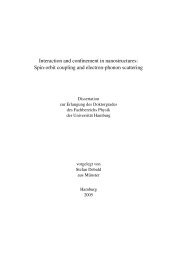Gravitinos and hidden Supersymmetry at the LHC - Universität ...
Gravitinos and hidden Supersymmetry at the LHC - Universität ...
Gravitinos and hidden Supersymmetry at the LHC - Universität ...
Create successful ePaper yourself
Turn your PDF publications into a flip-book with our unique Google optimized e-Paper software.
2.2. THE MINIMAL SUPERSYMMETRIC STANDARD MODEL<br />
<strong>and</strong> <strong>the</strong> i, j are <strong>the</strong> corresponding family indices. All of <strong>the</strong> gauge indices are suppressed.<br />
The µ term is <strong>the</strong> supersymmetric version of <strong>the</strong> Higgs boson mass <strong>and</strong> <strong>the</strong> only dimensionful<br />
supersymmetric parameter, which we choose to be real.<br />
Contrary to <strong>the</strong> case of <strong>the</strong> St<strong>and</strong>ard Model, <strong>the</strong> Yukawa couplings presented so far are<br />
not <strong>the</strong> most general couplings comp<strong>at</strong>ible with gauge invariance <strong>and</strong> renormalizability. Additional<br />
potentially dangerous terms viol<strong>at</strong>ing baryon <strong>and</strong> lepton number can be added. These<br />
terms are usually forbidden by discrete symmetry, R-parity, which will be <strong>the</strong> topic of <strong>the</strong><br />
next chapter. Therefore, <strong>at</strong> this stage <strong>the</strong> MSSM is defined as <strong>the</strong> model with <strong>the</strong> minimal<br />
field <strong>and</strong> coupling content.<br />
The description of <strong>the</strong> MSSM is completed with <strong>the</strong> specific<strong>at</strong>ion of <strong>the</strong> soft supersymmetry<br />
breaking terms discussed in <strong>the</strong> previous section:<br />
−L MSSM<br />
soft<br />
= 1 2 (M 3 g g + M 2 w w + M 1 b b + h.c.)<br />
(<br />
)<br />
+ a u ˜qH u ˜ū + a d ˜qH d ˜¯d + a<br />
e ˜lHd ˜ē + h.c.<br />
+ ˜m 2 q ˜q †˜q + ˜m 2 l ˜l †˜l + ˜m<br />
2<br />
u ˜ū †˜ū + ˜m 2 d ˜¯d† ˜¯d + ˜m<br />
2<br />
e ˜ē †˜ē<br />
+ m 2 u H † uH u + m 2 d H† d H d + (BH u H d + h.c.) . (2.25)<br />
In eq. (2.25), M 3 , M 2 , <strong>and</strong> M 1 are <strong>the</strong> gluino, wino, <strong>and</strong> bino mass terms. We have suppressed<br />
<strong>the</strong> adjoint represent<strong>at</strong>ion gauge indices on <strong>the</strong> wino <strong>and</strong> gluino fields, <strong>and</strong> <strong>the</strong> gauge indices<br />
on all of <strong>the</strong> chiral supermultiplet fields. The second line in eq. (2.25) contains <strong>the</strong> (scalar) 3<br />
couplings. Each of a u , a d , a e is a complex 3 × 3 m<strong>at</strong>rix in family space, with dimensions<br />
of [mass]. They are in one-to-one correspondence with <strong>the</strong> Yukawa couplings of <strong>the</strong> superpotential.<br />
The third line of eq. (2.25) consists of squark <strong>and</strong> slepton mass terms, <strong>the</strong> mass<br />
m<strong>at</strong>rices are in general 3 × 3 m<strong>at</strong>rices in family space th<strong>at</strong> can have complex entries, but <strong>the</strong>y<br />
must be hermitian so th<strong>at</strong> <strong>the</strong> Lagrangian is real. In <strong>the</strong> last line of eq. (2.25) one has <strong>the</strong><br />
supersymmetry-breaking contributions to <strong>the</strong> Higgs potential; m 2 u <strong>and</strong> m 2 d<br />
are squared-mass<br />
terms of <strong>the</strong> m 2 type, while B is <strong>the</strong> only squared-mass term of <strong>the</strong> type b in e.q. (2.20)<br />
th<strong>at</strong> can occur in <strong>the</strong> MSSM 1 . The dagger on H u <strong>and</strong> H d indic<strong>at</strong>es <strong>the</strong> contraction of <strong>the</strong><br />
doublets in contrast to terms like H u H d which should be read as ε ij H ui H dj , ε = iσ 2 being <strong>the</strong><br />
SU(2) metric. The soft breaking terms introduce many new parameters not present in <strong>the</strong><br />
St<strong>and</strong>ard Model. It turns out th<strong>at</strong> <strong>the</strong> MSSM Lagrangian has 105 physical masses, phases<br />
<strong>and</strong> mixing angles, which have no counterpart in <strong>the</strong> St<strong>and</strong>ard Model. This arbitrariness in<br />
<strong>the</strong> Lagrangian is not inherent to supersymmetry but arises from <strong>the</strong> unknown mechanism of<br />
supersymmetry breaking. Most of <strong>the</strong> new parameters imply flavor mixing or CP-viol<strong>at</strong>ing<br />
processes, which are restricted by experimental d<strong>at</strong>a. This is precisely <strong>the</strong> point <strong>at</strong>tacked<br />
by author of [95], as mentioned in <strong>the</strong> introduction to this chapter. Usually, it is assumed<br />
th<strong>at</strong> supersymmetry breaking is universal, meaning th<strong>at</strong> <strong>the</strong> squark <strong>and</strong> slepton squared-mass<br />
m<strong>at</strong>rices are flavor blind. Additionally, one assumes th<strong>at</strong> <strong>the</strong> scalar trilinear couplings are<br />
proportional to Yukawa couplings <strong>and</strong> th<strong>at</strong> <strong>the</strong> soft parameters do not introduce new complex<br />
phases. These rel<strong>at</strong>ions should result n<strong>at</strong>urally from <strong>the</strong> specific model for <strong>the</strong> origin of SUSY<br />
breaking. We will discuss such simplified models in <strong>the</strong> end of this chapter.<br />
For <strong>the</strong> l<strong>at</strong>er discussion we will need <strong>the</strong> effects of <strong>the</strong> electroweak symmetry breaking in<br />
<strong>the</strong> MSSM, which we introduce in <strong>the</strong> following section.<br />
1 The parameter called B in this work is often denoted by b or Bµ.<br />
19

















